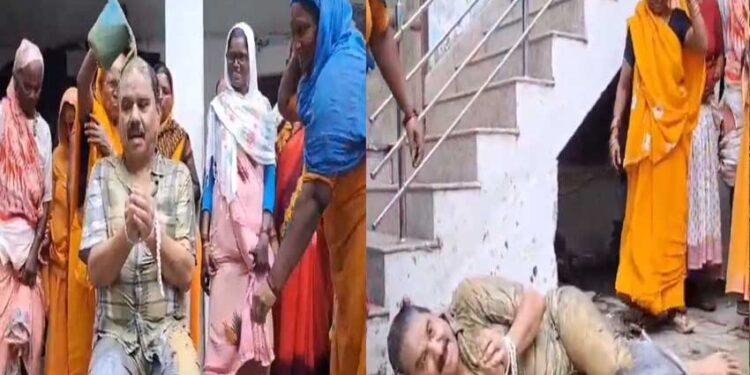Vinoba Bhave (English: Vinoba Bhave, born: 11 September 1895; died: 15 November 1982) was a respected follower of Mahatma Gandhi, one of the most well-known social reformers of India and the founder of the movement called ‘Bhoodan Yagna’. His entire life was like that of a sadhu and ascetic, due to which he became famous as a saint. Vinoba Bhave was a person with a very learned and thoughtful personality.
This warrior of ‘Jung e Azadi’, a great disciple of Mahatma Gandhi, studied and meditated upon many religious texts like Vedas, Vedanta, Gita, Ramayana, Quran, Bible etc. Vinoba Bhave also observed and contemplated deeply upon the modern principles of economics, politics and philosophy. Vinoba Bhave was born on 11 September 1895 in Gahode, Gujarat, India. Vinoba Bhave’s original name was Vinayak Narhari Bhave. Born in an aristocratic Brahmin family, Vinoba left his high school studies in 1916 to join the ‘Gandhi Ashram’. Gandhiji’s teachings inspired Bhave to lead his life as an ascetic for the improvement of Indian rural life.
Vinayak had a very sharp intellect. Mathematics became his favourite subject. He scored the highest marks in Mathematics in his high school examination. While doing his graduation in Baroda, Vinayak’s mind became very eager to become a recluse. In 1916, at the age of just 21, he left home and headed towards Kashi city to become a monk. In Kashi city, he started studying the scriptures under the guidance of Vedic scholars. There was talk all over the country about Mahatma Gandhi that he had come to India from South Africa and was busy blowing the trumpet of freedom. During his continuous self-study and practice of knowledge, Vinoba felt like meeting Gandhiji and he reached Kocharab Ashram in Ahmedabad. When he reached there, Gandhiji was cutting vegetables. Vinoba had probably not imagined that he would meet such a famous leader while cutting vegetables. He learnt the lesson of self-reliance and hard work without any advice. After this meeting, he became Bapu’s for life.
Under the guidance and guidance of Bapu, British jail became a pilgrimage for Vinoba. From 1921 to 1942, he went to jail many times. In 1922, he did the Nagpur Flag Satyagraha. The British government arrested Vinoba under Section 109 of the CrPC. Under this section, vagrants are arrested. In Nagpur jail, Vinoba was given the job of breaking stones. After a few months, he was sent to Akola jail. It was as if Vinoba’s Tapasya had begun. In 1925, he went to jail during the Harijan Satyagraha. In 1930, the National Congress under the leadership of Gandhi carried out the Salt Satyagraha.
On 12 March 1930, Gandhiji started the Dandi March. Vinoba again reached jail. This time he was kept in Dhuliya jail. Rajagopalacharya, who was also called Rajaji, wrote about Vinoba in ‘Young India’ that look at Vinoba, he has the purity of an angel. He is seated on the highest peaks of self-knowledge, philosophy and religion. His soul has imbibed so much humility that if a British officer does not recognize him, he cannot guess the greatness of Vinoba. In whichever category of jail he is kept, he keeps doing hard labour in the jail with his comrades. It is not even imagined how much torture this human being is silently enduring in the jail. On 11 October 1940, Vinoba was chosen by Gandhi as the first Satyagrahi of personal Satyagraha. Far from the desire for fame, Vinoba became very famous due to this Satyagraha. He had to go on moving forward, giving anti-war speeches in every village. Vinoba was arrested by the British government on 21 October. On 9 August 1942, he was arrested along with Gandhi and other big leaders of the Congress. This time he was first kept in Nagpur jail and then in Vellore jail.
In prison itself, at the age of 46, Vinoba started studying Arabic and Persian and also started reading the Quran. Vinoba, who had a very sharp intellect, soon became a Hafiz-e-Quran. He was already proficient in Marathi, Sanskrit, English, Gujarati, Bengali, English and French. Vinoba knew by heart about fifty thousand verses of various languages. He also made an extraordinary and tireless effort to apply all the acquired knowledge in his life.
In 1975, Bhave observed a year-long fast on the issue of his followers joining political movements. As a result of a hunger strike in 1979, the government passed a law to ban cow slaughter throughout India. When Vinoba ji realized that old age had surrounded him, he gave up food and water. When Acharya Vinoba ji gave up food and water, his supporters asked him about the source of energy to remain conscious, he told that he receives energy from air, sky etc. Acharya Vinoba said that ‘the day of death is not a day of sorrow but a day of celebration’, so he chose the day of Diwali, 15 November, as Nirvana Day for his death. Thus, due to giving up food and water, he gave up his life within a week on 15 November 1982, in Wardha, Maharashtra. After Vinoba ji left his body, all the sisters of Pavnar Ashram jointly cremated him. There are very few examples of such deaths in history. This type of dying is called Prayopavesh.










